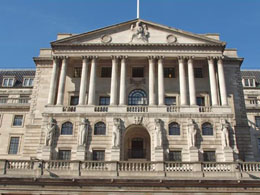
Seven in Ten Bankers Agree Monetary Policy Is No Longer Viable
The root cause of this problem is how a central bank is the “only player in town” to address economic turmoil. One thing most financial experts seem to agree on these days is how central banks find themselves in a precarious position. The Federal Reserve is sharing that opinion, as they feel central bank policy is doing more harm than good. In fact, 70% of bankers believe the monetary policy is a thing of the past. Central banks are on very thin ice, and more cracks start to appear every single day. Central banks have been using some interesting monetary policy options for several decades....
Related News
Forecasting how the global economy will evolve is becoming all but pointless. Anyone can create their own forecast and be right up to a certain extent, but the long-run scenario is impossible to guesstimate right now. Bitcoin users have no love lost for central bankers, and vice versa. Many central banks use rather unconventional monetary policy tools, which is causing friction within the banking sector itself. Something will have to change, as the advantages of Bitcoin and digital currency over central banks become more apparent every day. When people in the Bitcoin world hear the term....
The Bank of England's top economist has suggested that a digital currency based on bitcoin could alleviate monetary policy problems. Andrew Haldane, the UK central bank's chief economist and executive director for monetary analysis and statistics, spoke at the Portadown Chamber of Commerce in Northern Ireland on 18th September. During his speech, Haldane offered several ways in which central bankers can conduct monetary policy during a period when interest rates are close to or below zero. Haldane suggested that central bankers consider making measures like quantitative easing a permanent....
The European Central Bank is finally launching its major quantitative easing (QE) in order to fight the euro zone’s slide towards deflation. But with the evident failure of this monetary policy so far and the emergence of negative interest rates, is the ECB creating the perfect storm for virtual currencies as a viable alternative? From March this year until September 2016 the ECB will buy €60 billion (US$68 billion) of assets a month, a total of €1.1 trillion over the given period. Moreover, the President of the ECB, Mario Draghi, left room to extend the program if necessary. The ECB has....
The Central Banks of Japan and Europe have imposed negative interest rates on deposits. Would these blunt monetary tools of Central Bankers be effective if bitcoin adoption becomes widespread? Negative interest rates are the tools of Central Banks. Christine Lagarde, International Monetary Fund Managing Director, says: Negative interest rates are the emergency tools of Central Banks - they spur lending and investment in the economy when traditional measures have failed. Investors may tolerate marginal negative yields on sovereign debt because it is a safe investment, and they may be forced....
Adam Ludwin, chief executive officer at Chain, a San Francisco, Calif.-based startup that partners with businesses like Visa and Nasdaq to provide blockchain networks, explained how blockchains work and urged bankers to embrace the technology during a keynote address at the International Conference on Policy Challenges for the Financial Sector, held at the Federal Reserve in Washington, D.C., according to Bloomberg. The event was attended by central bankers from 90 countries, including officials from the World Bank, the Bank for International Settlements, the International Monetary Fund,....





